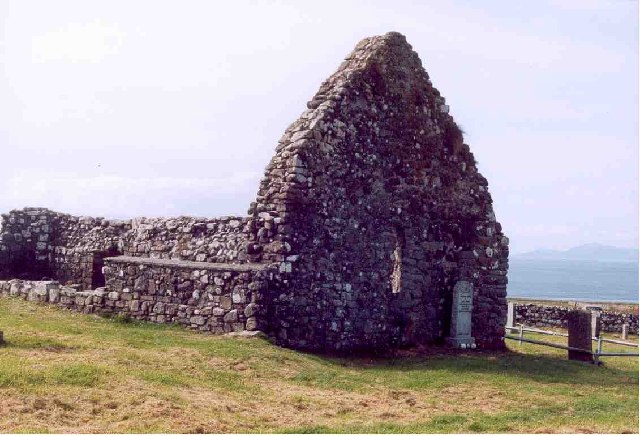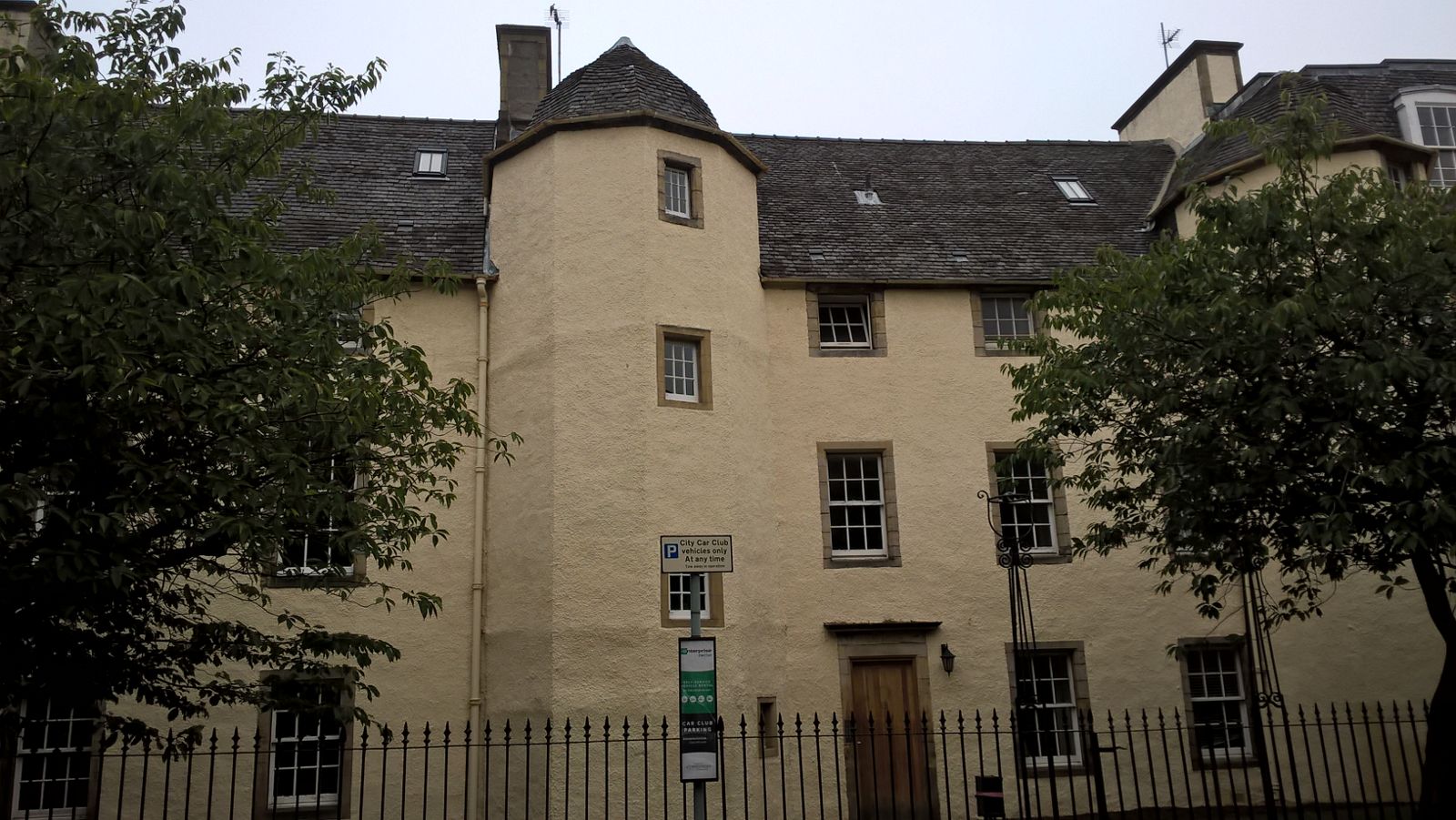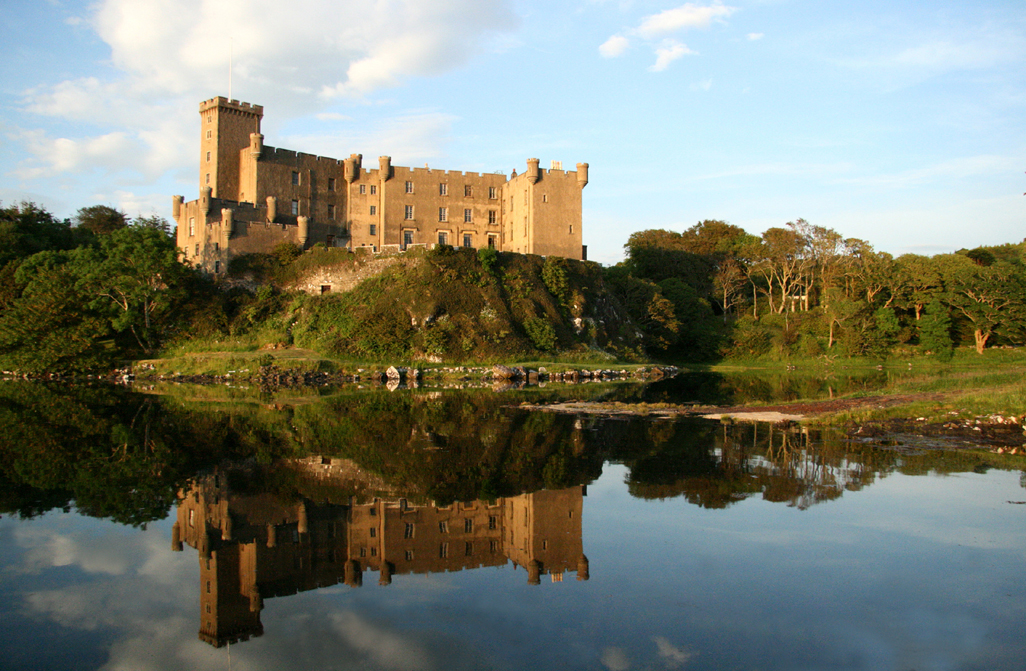|
Trumpan
Trumpan ( gd, Trumpan) is a hamlet located on the Vaternish peninsula in the Isle of Skye, in the Scottish council area of the Highland. Trumpan church, which is now a ruin, was the focus of a particularly brutal incident in 1578, when the Clan MacDonald of Uist travelled to Trumpan in eight boats and, under cover of a thick mist, burnt alive all the worshipping church-goers, with only one member managing to escape. This led to instant retribution by Clan MacLeod who killed all the invaders, before they had time to flee the island. This skirmish is known as the Battle of the Spoiling Dyke. Trumpan churchyard is the burial ground of Rachel Chiesley, Lady Grange whose husband had her kidnapped and incarcerated on various Hebridean The Hebrides (; gd, Innse Gall, ; non, Suðreyjar, "southern isles") are an archipelago off the west coast of the Scottish mainland. The islands fall into two main groups, based on their proximity to the mainland: the Inner and Outer Hebri . ... [...More Info...] [...Related Items...] OR: [Wikipedia] [Google] [Baidu] |
Rachel Chiesley, Lady Grange
Rachel Chiesley (baptised 4 February 1679 – 12 May 1745), usually known as Lady Grange, was the wife of Lord Grange, a Scottish lawyer with Jacobite sympathies. After 25 years of marriage and nine children, the Granges separated acrimoniously. When Lady Grange produced letters that she claimed were evidence of his treasonable plottings against the Hanoverian government in London, her husband had her kidnapped in 1732. She was incarcerated in various remote locations on the western seaboard of Scotland, including the Monach Isles, Skye and St Kilda. Lady Grange's father was convicted of murder and she is known to have had a violent temper; initially her absence seems to have caused little comment. News of her plight eventually reached her home town of Edinburgh and an unsuccessful rescue attempt was undertaken by her lawyer, Thomas Hope of Rankeillor. She died in captivity, after being in effect imprisoned for over 13 years. Her life has been remembered in poet ... [...More Info...] [...Related Items...] OR: [Wikipedia] [Google] [Baidu] |
Waternish
Waternish or Vaternish ( gd, Bhàtairnis) is a peninsula approximately long on the island of Skye, Scotland, situated between Loch Dunvegan and Loch Snizort in the northwest of the island, and originally inhabited and owned by Clan MacNeacail/MacNicol/Nicolsons. About the time of the battle of Bannockburn in the beginning of the 14th century, the line of the MacNicol chiefs ended in an heiress, who married Torcuil MacLeod of the Lewes, a younger son of MacLeod of the Lewis, who obtained a Crown charter of the lands of Assynt, and other lands in the west of Ross, apparently those which had become vested in his MacNicol wife. The clan, on this event, came by the patriarchal rule, or law of clanship, under the leading of the nearest male heir; and the MacNicails subsequently removed to the Isle of Skye, where their chief residence was at Scoirebreac, a beautiful situation, on the margin of the loch, close to Port Rhi (Portree). In the 17th century, John Morison of Bragar stated ... [...More Info...] [...Related Items...] OR: [Wikipedia] [Google] [Baidu] |
Isle Of Skye
The Isle of Skye, or simply Skye (; gd, An t-Eilean Sgitheanach or ; sco, Isle o Skye), is the largest and northernmost of the major islands in the Inner Hebrides of Scotland. The island's peninsulas radiate from a mountainous hub dominated by the Cuillin, the rocky slopes of which provide some of the most dramatic mountain scenery in the country. Slesser (1981) p. 19. Although has been suggested to describe a winged shape, no definitive agreement exists as to the name's origins. The island has been occupied since the Mesolithic period, and over its history has been occupied at various times by Celtic tribes including the Picts and the Gaels, Scandinavian Vikings, and most notably the powerful integrated Norse-Gaels clans of MacLeod and MacDonald. The island was considered to be under Norwegian suzerainty until the 1266 Treaty of Perth, which transferred control over to Scotland. The 18th-century Jacobite risings led to the breaking-up of the clan system and later cleara ... [...More Info...] [...Related Items...] OR: [Wikipedia] [Google] [Baidu] |
Highland (council Area)
Highland ( gd, A' Ghàidhealtachd, ; sco, Hieland) is a council area in the Scottish Highlands and is the largest local government area in the United Kingdom. It was the 7th most populous council area in Scotland at the 2011 census. It shares borders with the council areas of Aberdeenshire, Argyll and Bute, Moray and Perth and Kinross. Their councils, and those of Angus and Stirling, also have areas of the Scottish Highlands within their administrative boundaries. The Highland area covers most of the mainland and inner-Hebridean parts of the historic counties of Inverness-shire and Ross and Cromarty, all of Caithness, Nairnshire and Sutherland and small parts of Argyll and Moray. Despite its name, the area does not cover the entire Scottish Highlands. Name Unlike the other council areas of Scotland, the name ''Highland'' is often not used as a proper noun. The council's website only sometimes refers to the area as being ''Highland'', and other times as being ''the Hig ... [...More Info...] [...Related Items...] OR: [Wikipedia] [Google] [Baidu] |
Hallin
Scandza was described as a "great island" by Gothic-Byzantine historian Jordanes in his work ''Getica''. The island was located in the Arctic regions of the sea that surrounded the world. The location is usually identified with Scandinavia. Jordanes was a Roman citizen living in Constantinople but described himself as being of Gothic descent. His ''Getica'', written in 551 AD, gives a history of the Goths, beginning in Scandza from where they later migrated to Gothiscandza, near the mouth of the Vistula River. The Swedish archaeologist Göran Burenhult describes this account as a unique glimpse into the tribes of Scandinavia in the 6th century. Geographical description through history Early Greek and Roman geographers used the name ''Scandia'' for various uncharted islands in Northern Europe. The name originated in Greek sources, which used it for a long time for different islands in the Mediterranean region. In the Iliad the name denotes an ancient city in Kythira, Greece. ... [...More Info...] [...Related Items...] OR: [Wikipedia] [Google] [Baidu] |
Ruined Church, Trumpan, Skye - Geograph
Ruins () are the remains of a civilization's architecture. The term refers to formerly intact structures that have fallen into a state of partial or total disrepair over time due to a variety of factors, such as lack of maintenance, deliberate destruction by humans, or uncontrollable destruction by natural phenomena. The most common root causes that yield ruins in their wake are natural disasters, armed conflict, and population decline, with many structures becoming progressively derelict over time due to long-term weathering and scavenging. There are famous ruins all over the world, with notable sites originating from ancient China, the Indus Valley and other regions of ancient India, ancient Iran, ancient Israel and Judea, ancient Iraq, ancient Greece, ancient Egypt, Roman sites throughout the Mediterranean Basin, and Incan and Mayan sites in the Americas. Ruins are of great importance to historians, archaeologists and anthropologists, whether they were once individual f ... [...More Info...] [...Related Items...] OR: [Wikipedia] [Google] [Baidu] |
Hamlet (place)
A hamlet is a human settlement that is smaller than a town or village. Its size relative to a Parish (administrative division), parish can depend on the administration and region. A hamlet may be considered to be a smaller settlement or subdivision or satellite entity to a larger settlement. The word and concept of a hamlet has roots in the Anglo-Norman settlement of England, where the old French ' came to apply to small human settlements. Etymology The word comes from Anglo-Norman language, Anglo-Norman ', corresponding to Old French ', the diminutive of Old French ' meaning a little village. This, in turn, is a diminutive of Old French ', possibly borrowed from (West Germanic languages, West Germanic) Franconian languages. Compare with modern French ', Dutch language, Dutch ', Frisian languages, Frisian ', German ', Old English ' and Modern English ''home''. By country Afghanistan In Afghanistan, the counterpart of the hamlet is the Qila, qala (Dari language, Dari: ... [...More Info...] [...Related Items...] OR: [Wikipedia] [Google] [Baidu] |
Scotland
Scotland (, ) is a country that is part of the United Kingdom. Covering the northern third of the island of Great Britain, mainland Scotland has a border with England to the southeast and is otherwise surrounded by the Atlantic Ocean to the north and west, the North Sea to the northeast and east, and the Irish Sea to the south. It also contains more than 790 islands, principally in the archipelagos of the Hebrides and the Northern Isles. Most of the population, including the capital Edinburgh, is concentrated in the Central Belt—the plain between the Scottish Highlands and the Southern Uplands—in the Scottish Lowlands. Scotland is divided into 32 administrative subdivisions or local authorities, known as council areas. Glasgow City is the largest council area in terms of population, with Highland being the largest in terms of area. Limited self-governing power, covering matters such as education, social services and roads and transportation, is devolved from the Scott ... [...More Info...] [...Related Items...] OR: [Wikipedia] [Google] [Baidu] |
Highland Council Area
Highland ( gd, A' Ghàidhealtachd, ; sco, Hieland) is a council area in the Scottish Highlands and is the largest local government area in the United Kingdom. It was the 7th most populous council area in Scotland at the 2011 census. It shares borders with the council areas of Aberdeenshire, Argyll and Bute, Moray and Perth and Kinross. Their councils, and those of Angus and Stirling, also have areas of the Scottish Highlands within their administrative boundaries. The Highland area covers most of the mainland and inner-Hebridean parts of the historic counties of Inverness-shire and Ross and Cromarty, all of Caithness, Nairnshire and Sutherland and small parts of Argyll and Moray. Despite its name, the area does not cover the entire Scottish Highlands. Name Unlike the other council areas of Scotland, the name ''Highland'' is often not used as a proper noun. The council's website only sometimes refers to the area as being ''Highland'', and other times as being ''the Highl ... [...More Info...] [...Related Items...] OR: [Wikipedia] [Google] [Baidu] |
Uist
"Uist" is a group of six islands and are part of the Outer Hebridean Archipelago, part of the Outer Hebrides of Scotland. North Uist and South Uist ( or ; gd, Uibhist ) are two of the islands and are linked by causeways running via the isles of Benbecula and Grimsay. From south to north, the inhabited islands in the island group are (Eriskay), (South Uist), Grimsay (South), (Benbecula), ( Flodaigh), ( Grimsay (North)), , (North Uist), (Baleshare) and ( Berneray). The islands, collectively, have a population of 4,723. Major settlements The main settlements in Uist are: South Uist * (Daliburgh) * (Lochboisdale) * ( Snishvale) * (Stoneybridge) * (Eochar) * ( Polochar) * (Eriskay) Benbecula * (Balivanich) * ( Creagorry) * ( Liniclate) North Uist * ( Carinish) * ( Bayhead) * (Sollas) * (Lochmaddy) * (Balemore) 16th century Geography Writing in 1549, Sir Donald Monro, High Dean of the Isles stated of "Ywst" that it was a fertile country full of hi ... [...More Info...] [...Related Items...] OR: [Wikipedia] [Google] [Baidu] |
Clan MacLeod
Clan MacLeod (; gd, Clann Mac Leòid ) is a Highland Scottish clan associated with the Isle of Skye. There are two main branches of the clan: the MacLeods of Harris and Dunvegan, whose chief is MacLeod of MacLeod, are known in Gaelic as ' ("seed of Tormod"); the Clan MacLeod of Lewis and Raasay, whose chief is MacLeod of The Lewes ( gd, Mac Ghille Chaluim), are known in Gaelic as ' ("seed of Torcall"). Both branches claim descent from Leòd, who lived in the 13th century. Today, Clan MacLeod of The Lewes, Clan MacLeod of Raasay, and Clan MacLeod are represented by "Associated Clan MacLeod Societies", and the chiefs of the three clans. The association is made up of ten national societies across the world including: Australia, Canada, England, France, Germany, New Zealand, Scotland, South Africa, Switzerland, and the United States. History Origins The surname MacLeod means 'son of Leod'. The name Leod is an Anglicization of the Scottish Gaelic name Leòd, which is thought to ... [...More Info...] [...Related Items...] OR: [Wikipedia] [Google] [Baidu] |









